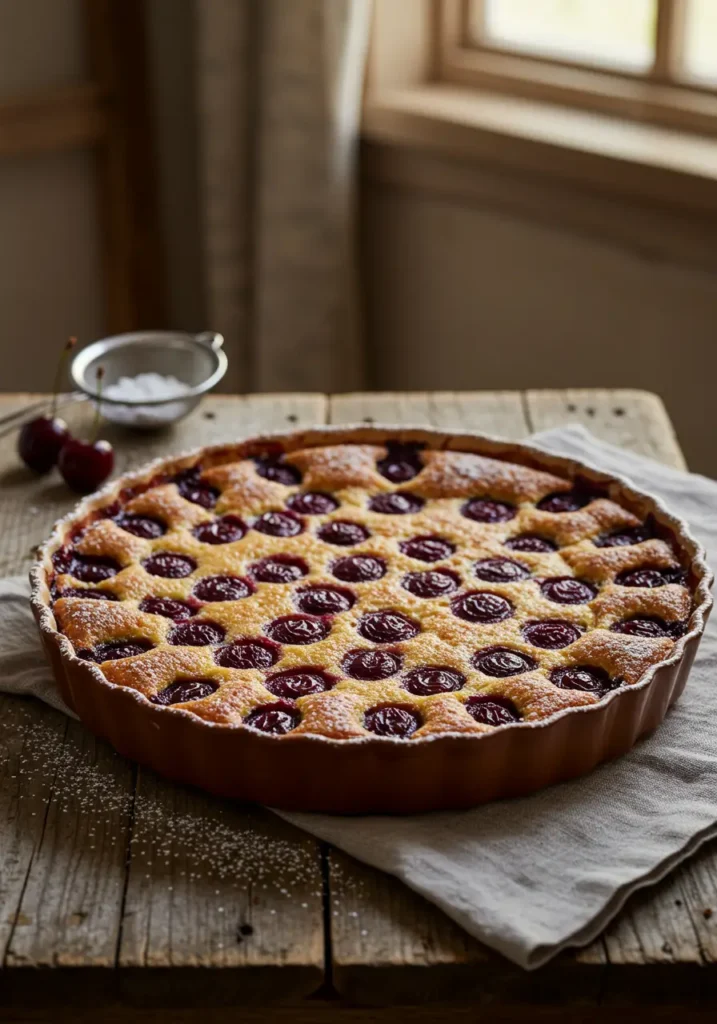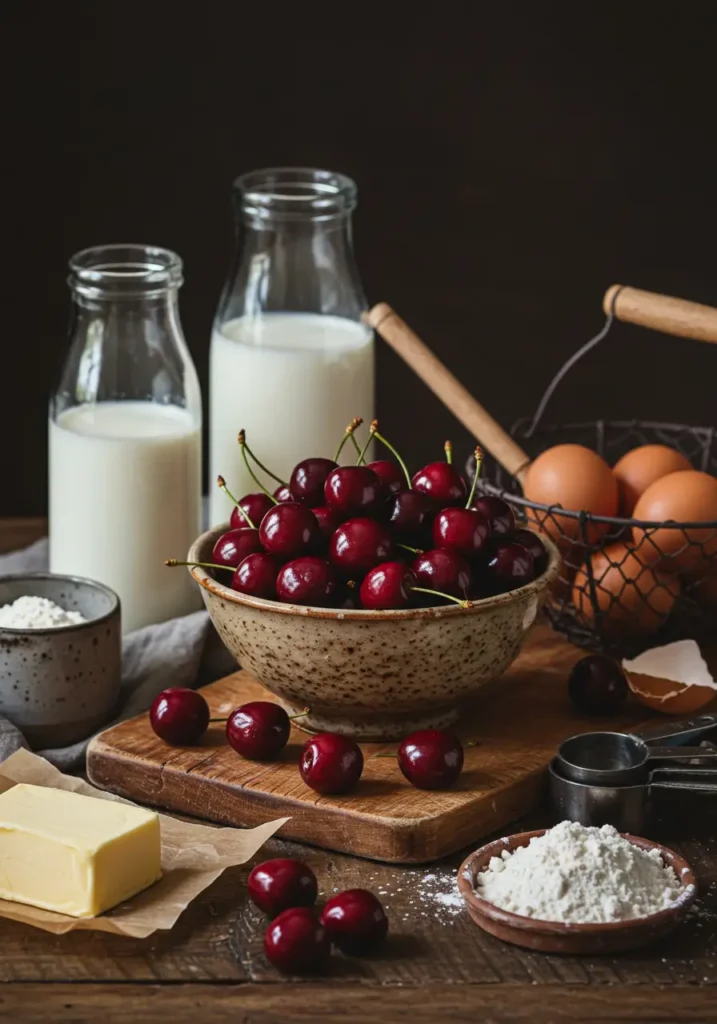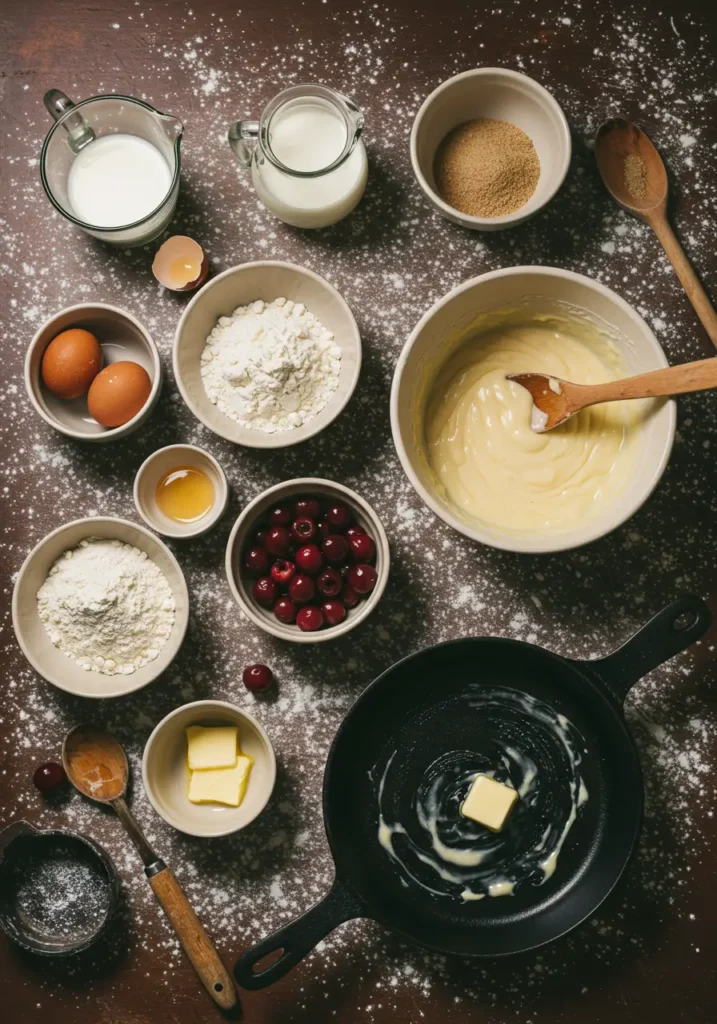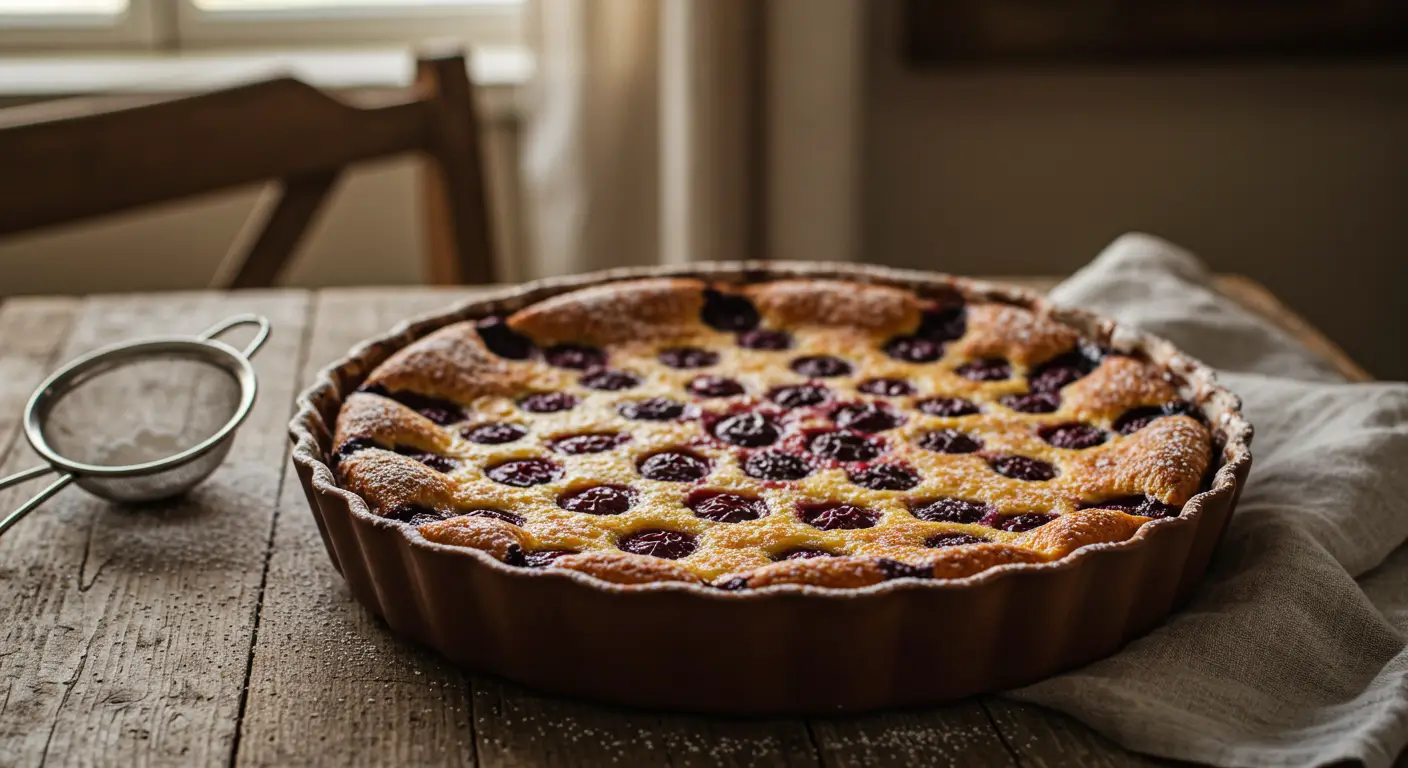The Best French Cherry Clafoutis Recipe: A Foolproof Guide to This Rustic French Dessert
Picture this: you’re strolling through a Parisian market on a lazy Sunday morning, and the sweet aroma of baked cherries wafts through the air. That, my friend, is probably someone making clafoutis – and honestly, it’s about to become your new obsession.
I stumbled upon this magical dessert during my first trip to France about eight years ago. My host family served it for dessert, and I literally asked for the recipe before I’d even finished my first bite. The grandmother just laughed and said, “C’est très simple!” And you know what? She was absolutely right.
Clafoutis is basically the lovechild of a pancake and a custard – imagine if they had a baby and decided to throw some gorgeous fresh cherries into the mix. It’s rustic, it’s elegant, and it’s ridiculously easy to make. Plus, it’s one of those desserts that makes you look like a total culinary genius when really, you just mixed some stuff in a bowl and baked it.
Table of Contents :

What Exactly Is Cherry Clafoutis?
Let’s get nerdy for a hot minute. Clafoutis (pronounced “kla-foo-TEE” – yes, you do pronounce that final ‘s’) is a traditional French dessert that originated in the Limousin region. The classic version uses unpitted black cherries because, according to French tradition, the pits add an almond-like flavor during baking.
Now, before you start freaking out about cherry pits, let me tell you – I’m team pitted cherries all the way. Life’s too short to worry about breaking a tooth on dessert, IMO. The flavor difference is minimal, and your dinner guests will thank you.
The texture? Think somewhere between a thick pancake and a light custard. It’s custardy on the bottom, slightly cake-like on top, and those cherries create these beautiful pockets of jammy sweetness throughout. It’s comfort food that happens to be fancy enough for company.
Why This Recipe Works Every Single Time
Here’s the thing about clafoutis – it’s nearly impossible to mess up. But after making this probably 50+ times over the years, I’ve figured out a few tricks that take it from “pretty good” to “absolutely spectacular.”
The batter is intentionally lumpy. Don’t overthink this part. A few lumps actually give you better texture than a perfectly smooth batter. Trust me on this one.
Fresh cherries are non-negotiable during cherry season (roughly May through August). Frozen can work in a pinch, but fresh cherries have that perfect balance of tartness and sweetness that makes this dessert sing.
The pan matters more than you think. I use a well-buttered 9-inch ceramic tart pan or cast iron skillet. The ceramic gives you those gorgeous golden edges, while cast iron creates an almost caramelized bottom crust.
The Perfect Cherry Clafoutis Recipe
Ingredients You’ll Need:

For the fruit:
- 1.5 pounds fresh sweet cherries, pitted (about 4 cups)
- 2 tablespoons granulated sugar
- 1 tablespoon kirsch or brandy (optional, but highly recommended)
For the batter:
- 4 large eggs, room temperature
- 1/2 cup granulated sugar
- 1/3 cup all-purpose flour
- 1/4 teaspoon fine sea salt
- 1 cup whole milk
- 1/4 cup heavy cream
- 2 tablespoons unsalted butter, melted
- 1 teaspoon vanilla extract
- 1/4 teaspoon almond extract (secret weapon!)
For finishing:
- Butter for greasing the pan
- Powdered sugar for dusting
- Extra fresh cherries for garnish (optional)
Step-by-Step Instructions:
Prep Work (Don’t Skip This!)

Step 1: Get your oven ready. Preheat to 375°F (190°C). Position your rack in the center of the oven.
Step 2: Cherry prep time. If you’re using fresh cherries, pit them over a bowl to catch the juices – you’ll want to save those! Toss the pitted cherries with 2 tablespoons of sugar and the kirsch if using. Let them macerate while you make the batter. This step draws out the juices and intensifies the flavor.
Pro tip: Use a cherry pitter if you have one, or push the pits out with a chopstick. Messy but effective!
Making the Magic Happen
Step 3: Whisk the eggs and sugar. In a large bowl, whisk the eggs and 1/2 cup sugar until well combined and slightly pale. Don’t go crazy here – we’re not making meringue.
Step 4: Add the dry ingredients. Whisk in the flour and salt until just combined. A few lumps are totally fine – actually, they’re preferred!
Step 5: Gradually add the liquids. Slowly whisk in the milk, cream, melted butter, vanilla, and almond extract. The batter should be smooth but not overmixed. Think pancake batter consistency.
FYI: Room temperature ingredients mix together more easily and create a smoother final texture.
Assembly and Baking
Step 6: Prep your pan. Generously butter your 9-inch tart pan, pie dish, or cast iron skillet. I’m talking really generous here – this prevents sticking and creates those gorgeous crispy edges.
Step 7: Arrange the cherries. Distribute the macerated cherries evenly across the bottom of your prepared pan. Pour any accumulated juices over them.
Step 8: Pour and bake. Pour the batter over the cherries – it’ll look like there’s way too much liquid, but trust the process. The batter will puff up and set around the fruit as it bakes.
Bake for 35-45 minutes, until the top is golden brown and the center is just set. The clafoutis should be slightly jiggly in the very center – it’ll continue cooking from residual heat.
The Final Touch
Step 9: Cool and serve. Let it cool for at least 15 minutes before serving. This allows the custard to set properly. Dust with powdered sugar right before serving for that classic French presentation.
Pro Tips for Clafoutis Success
Ingredient Swaps and Substitutions
Cherry alternatives: While traditional clafoutis uses cherries, you can absolutely experiment. Plums, pears, berries, or even stone fruits work beautifully. Just adjust the sugar based on the fruit’s natural sweetness.
Dairy modifications: You can substitute the heavy cream with more milk, but the texture won’t be quite as rich. For a lighter version, use 2% milk instead of whole milk.
Gluten-free option: Replace the all-purpose flour with a 1:1 gluten-free flour blend. The texture will be slightly different but still delicious.
Timing and Storage
Make-ahead friendly: You can prepare the batter and macerate the cherries up to 4 hours ahead. Just combine them right before baking.
Storage: Clafoutis keeps in the refrigerator for up to 3 days. It’s delicious cold, at room temperature, or gently rewarmed in a 300°F oven for 10 minutes.
Freezing: While possible, I don’t recommend freezing clafoutis. The texture becomes a bit watery when thawed.
Troubleshooting Common Issues
“My clafoutis didn’t set properly!”
This usually happens when the oven temperature is too low or the baking time is too short. The center should be just barely jiggly when you remove it from the oven. If it’s still very liquid, give it another 5-10 minutes.
“The bottom is soggy!”
This typically occurs when there’s too much liquid from the fruit. Next time, drain some of the macerated cherry juices before adding the fruit to the pan, or reduce the milk slightly.
“It’s too eggy!”
Some people find clafoutis too custard-like. If that’s you, reduce the eggs to 3 and increase the flour to 1/2 cup for a more cake-like texture.
Serving Suggestions and Variations
Classic Presentation
Serve clafoutis slightly warm or at room temperature, dusted with powdered sugar. A dollop of lightly sweetened whipped cream or a scoop of vanilla ice cream takes it to the next level.
Flavor Variations
Chocolate cherry: Add 2 tablespoons of cocoa powder to the batter for a chocolate version that’s absolutely divine.
Almond clafoutis: Increase the almond extract to 1/2 teaspoon and add 2 tablespoons of ground almonds to the batter.
Boozy version: Besides kirsch, try rum, amaretto, or even a splash of cherry brandy in the fruit mixture.
Nutritional Benefits (Yes, Really!)
Before you write this off as pure indulgence, clafoutis actually has some nutritional merit. The eggs provide high-quality protein, the milk adds calcium, and those gorgeous cherries are packed with antioxidants and vitamin C.
Cherries also contain natural melatonin, which might help with sleep – though I can’t guarantee you’ll be sleepy after eating this
The Cultural Story Behind This Dessert
Here’s something cool: clafoutis was traditionally made by farmers’ wives using whatever fruit was abundant. It was an economical way to use up fruit that was getting too ripe for eating fresh. The beauty of this dessert lies in its simplicity and adaptability.
In France, there’s actually a distinction between clafoutis (made with cherries) and flaugnarde (made with other fruits). But honestly? Most people use the terms interchangeably now, and I’m not about to police your French dessert vocabulary.
Final Thoughts: Why You Need This Recipe in Your Life
Look, I’ve made a lot of desserts over the years – some ridiculously complicated, some that required three days and a engineering degree. But clafoutis? This is the dessert I actually make for my family on a random Tuesday night because I have some cherries that need using up.
It’s impressive enough for dinner parties but easy enough for weeknight dessert. It uses simple ingredients you probably have on hand. And unlike some finicky French desserts (looking at you, soufflé), this one is basically foolproof.
The best part? Every time I make it, I’m transported back to that little kitchen in France where I first fell in love with this rustic, elegant, absolutely delicious dessert.
So grab some cherries, preheat that oven, and get ready to add a new favorite to your dessert repertoire. Your taste buds will thank you, and you might just find yourself planning your next trip to France.
Pro tip: Make this once, and I guarantee you’ll be the person everyone asks to bring dessert to the potluck. You’re welcome in advance!

